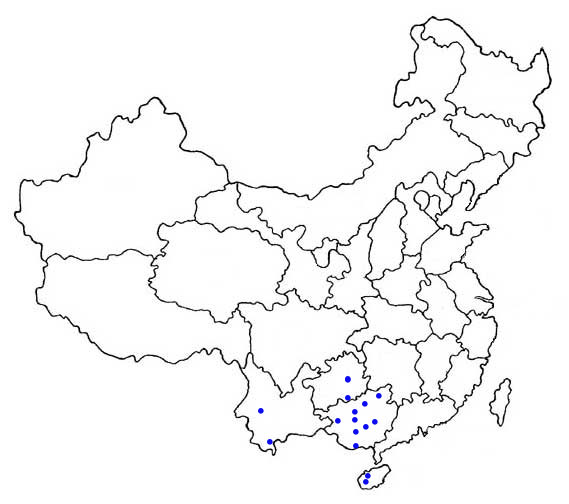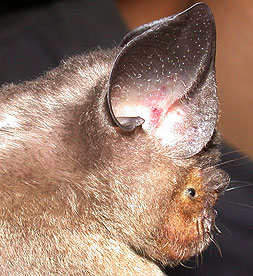Hipposideros larvatus
Intermediate Roundleaf Bat; Horsfield's Leaf-nosed Bat
Morphological description Life history Distribution Habitat Roost sites and roosting patterns Emergence and flight pattern Foraging behaviour Echolocation calls Status and protection
Morphological Description
· Dorsal fur is a uniform cinnamon brown. Ventral fur is lighter, grey.
· Juveniles are darker than adults.
· It is a medium leaf-nosed bat. Average forearm length 55.5-62.2mm (measured in southern China in September, 2002-2003). Average values are 60.28 +/- 1.74 mm (n = 20) for males, 60.79 +/- 2.01 mm (n = 19) for females (Thabah et al. 2006).
· The number of supplementary leaflets is three (lower left hand image)..
· Body masses in China - 17.4 g - 24.8 g. Mean values were 21.04 +/- 3.46 g for males, 20.12 +/- 2.36 g from females (Thabah, 2006).
· Ear length 19.87 +/- 2.13 mm males; 18.50 +/- 1.53 mm females.
Life history
· Little known
Distribution
The distribution in China is shown by the dots on the map (as given by Zhang et al. 1997).

Habitat
· Bates & Harrison (1997) noted that this species was found at altitudes from 182 metres to 860 metres. We found this bat up to 1480 metres in Yunnan .
Roost sites and roosting behaviour
· Caves are the typical diurnal roosts. Roosts may contain several hundred bats of both sexes.
· This species often shares their roosts with other bat species.
Emergence and flight pattern
· Most hipposiderid bats have wing shapes that make them adept at foraging in cluttered environments.
Foraging behaviour
· Little known
Echolocation calls
The echolocation call is a short constant frequency signal, with a brief frequency-modulated start and tail.
Call frequencies: frequencies of most energy at 82.64 +/- 2.62 kHz (n = 20) for males; 82.32 +/- 1.71 kHz kHz (n = 19) for females. Thabah et al. 2006). call frequency varies substantially across the range for H. larvatus, and several cryptic species may be present. Phylogenetically the Chinese bats were close to Malaysian bats, in a clade distinct from bats from Myanmar and India, which are more likely to represent Hipposideros grandis and H. khasiana (Thabah et al., 2006).
Status and protection
· Chinese bats may be a distinct subspecies (or possibly species) from bats in Malaysia because they echolocate at different frequencies, and show substantial genetic divergence. the subspecific name H.l. poutensis was initially applied to Chinese H. larvatus (Allen, 1906).
There is no estimation of population size of China. the species is frequently encountered in caves in the south.
· Intermediate leaf-nosed bats are at LR/lc, assessed by the Red List of Threatened Species (IUCN, 2006) and are not listed in the Law of the People's Republic of China on the Protection of Wildlife in 1989.
· Caves and old buildings should be protected as their habitats.
